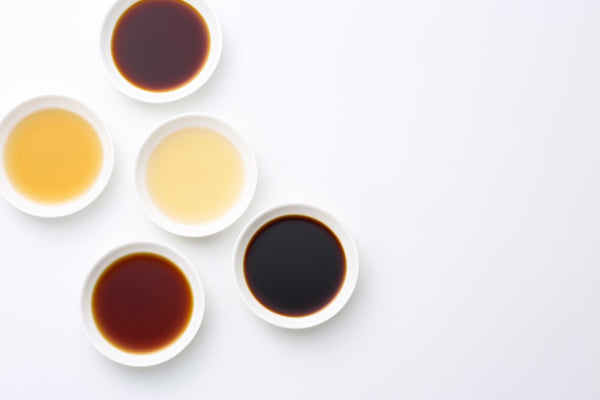
Jump to:
There is a wide range of Shoyu, or Japanese soy sauce available on the market. Whereas the big hitters (with an approximate 90% share) are Koikuchi (dark) Shoyu and Usukuchi (light in color) Shoyu, they are certainly not the only players in town.
This article covers Shiro Shoyu, one of the lesser-known and less frequently used types. Shiro Shoyu, as its name suggests, is pale or virtually translucent in color and has a completely different taste profile to what we think of as regular shoyu.
In this article, we will discuss the ingredients of Shiro Shoyu, its history, and its similarities and differences with other types of shoyu, as well as Shiro Dashi. We shall also look at the way it is used in cooking and introduce a Japanese brand boasting an impressive organic type of Shiro Shoyu.
What Is Shiro Shoyu Made Of?

The dark type of Shoyu most people associate with soy sauce is made of approximately equal parts of wheat and soybeans and fermented for a long period of time (at least six months). This long fermentation process causes significant amounts of its proteins to be broken down, leading to a darker color, a strong flavor with lots of umami, and a rich aroma.
Shiro Shoyu on the other hand has a much higher ratio of wheat to soybeans (typically around 90:10) and is fermented for a much shorter period (no longer than three months), which accounts for its pale color. Its aroma and taste are also, naturally, very wheat-based. Its high wheat ratio means that its sugar content tends to be higher than regular Shoyu, giving it a very different flavor profile.
Controversially, some sauces that refer to themselves as Shiro Shoyu do not contain any soybeans at all. As this means, of course, that the soy element of soy sauce is not present, many people in the industry consider it wrong to refer to such sauces as Shoyu.
What Are The Origins Of Shiro Shoyu?

The origins of Shiro Shoyu date back to 1802 in the Mikawa region of Japan, which is currently known as Hekinan City. This is a part of Aichi Prefecture where the Yamashin Brewery is located and is an area that has long been associated with a thriving brewing industry, including the production of mirin (sweet sake), sake, miso, and tamari soy sauce. During the Edo period (1603-1867), the city was said to be a food hub that supplied its wares to the densely populated city of Edo via the sea.
Shiro Shoyu was born from an experiment to see whether the Jojiru (top soup) of Kinzanji miso, which is light in color and highly palatable, could be used as a seasoning. The manufacturing process is different from that of regular Shoyu in that the soybeans are roasted, and the wheat is steamed. Further, the moromi (or mash) is not stirred, which allows the Shiro Shoyu to accumulate at the bottom. This provides the first batch of Shiro Shoyu. The remaining moromi is then pressed to provide the second batch.
Shiro Shoyu Vs Other Types of Shoyu & Shiro Dashi

We have already touched on the differences between Shiro Shoyu and Koikuchi (dark) Shoyu in terms of ingredient balance and fermentation time. One thing that should be noted is that despite its light amber color and mild flavor, Shiro Shoyu has a higher salt content than Koikuchi Shoyu.
Although Usukuchi Shoyu, particularly popular in the Kansai area, uses a much higher ratio of soybeans than Shiro Shoyu, there are similarities to the extent that both types are used with dishes where the aim is to bring out the natural color and flavor of the ingredients they are cooked with. A difference, on the other hand, is that Shiro Shoyu has much more of a wheat-based taste and lacks the umami of Usukuchi Shoyu. This is because the umami of Shoyu mainly comes from the breakdown of proteins in the soybeans. During the fermentation process, these proteins are broken down into 20 different amino acids. Glutamic acid, in particular, is responsible for the savory umami taste of Shoyu, and this is naturally lower in Shiro Shoyu due to the low (or non-existent) ratio of soybeans.
If you are looking for a wheat-based taste AND loads of umami, then you might like to give Shiro Dashi a try. With Shiro Dashi, a traditional dashi containing bonito flakes, mackerel flakes, and shiitake mushrooms and the like, is combined with Shiro Shoyu, mirin, and sugar to give it a savory, salty, umami-packed stock base with a light yellow or amber color. If the recipe you are following calls for Shiro Dashi and you don’t have any in the house, at a pinch you can recreate something similar by simply adding Shiro Shoyu to ordinary dashi. The Japanese Taste website features a wide range of Shiro Dashi that you can try.
How Is Shiro Shoyu Used In Cooking?

Shiro Shoyu is widely considered to be unsuitable for use as a dipping sauce. It is most often used in dishes that are designed to bring out the color of the ingredients or when dashi is added. It is thus the choice of many chefs when making clear soups, or suimono, so that it can enhance the umami flavor of the other ingredients in the soup while keeping the broth beautifully clear.
In Aichi Prefecture, where it was invented, it is most commonly used to add a subtle wheat flavor to the soup for Udon noodles, Chawanmushi (steamed egg custard), and Dashimaki Tamago (rolled egg). It is a great choice if you want to add flavor to a rice dish, such as Takikomi gohan (where meat, fish, vegetables, and the like are cooked together with rice) while still retaining the natural color of the ingredients.
Meat can also be soaked in Shiro Shoyu to make fritters. A small amount can also be added as an alternative to salt when you want to bring out the natural flavors of the food, such as making salted ice cream by pouring a little over vanilla ice cream. It can also be added to white wine vinegar to make a refreshing salad dressing.
As already mentioned, Shiro Shoyu, despite its light color, has a deceptively high salt content. In fact, at a whopping 18%, it has the highest salt content out of any of the major types of Shoyu, so it is advisable to add it a little at a time and taste as you go, particularly when first starting to use it in your cooking.
Japan's Leading Organic Shiro Shoyu Brand

Shiro Shoyu to this day is considered a specialty product of Aichi Prefecture, and Aichi-based Hichifuku Brewing Company claims to be unique among Shoyu producers in Japan for offering a certified organic Shiro Shoyu, from its JAS (Japan Agricultural Standards)-certified plants. The JAS mark can only be applied by registered business entities that have been certified by the accredited certification body to have complied with strict JAS standards related to organic production. In Japan, it is prohibited to sell products with descriptions such as organic (or “有機”) without this accreditation.
Hichifuku organic Shiro Shoyu uses JAS-certified wheat and soybeans, at a ratio of 90:10, and as heat sterilization is not carried out, the enzymes stay active during production, breaking down the wheat starch into glucose to provide additional sweetness. Although using organic ingredients leads to an increase of approximately three times the raw material costs compared to non-organic sources, the company asserts that they are committed to “creating a healthy product” and continue to research different ingredients from around the world in an attempt to improve its quality.
Hichifuku prepares Shiro Shoyu using a single deep fermentation tank, as there is a limit to the amount of fermentation and sanitary control that can be provided using traditional wooden vats. By using one large tank (equivalent to approximately 10 wooden vats), they are able to ensure a stable supply to the market and produce a product in sanitary conditions with a consistent level of quality. The tank is refrigerated in an environment where the temperature is controlled 24 hours a day, and the Shoyu is aged at a lower temperature and for a longer period of time than other Shiro Shoyu, to enable them to produce a higher quality, more flavorsome Shiro Shoyu.
If you are interested in trying Hichifuku’s high-quality, organic Shiro Shoyu, you can find it here on the Japanese Taste website.
Shiro Shoyu – Another String To Your Culinary Bow

Although paling in terms of market share compared to Koikuchi Shoyu and Usukuchi Shoyu, Shiro Shoyu offers something different and is definitely worth including as part of your toolkit when cooking Japanese food.
The high ratio of wheat used when brewing Shiro Shoyu gives it a distinctive sweet but salty taste that brings out the natural flavors of the ingredients you cook with it. Although lacking in umami, it can be combined with dashi either by itself or as part of shiro dashi to make delicious soups and broths.
Have you tried using Shiro Shoyu in your cooking yet? Let us know in the comments.


0 comments